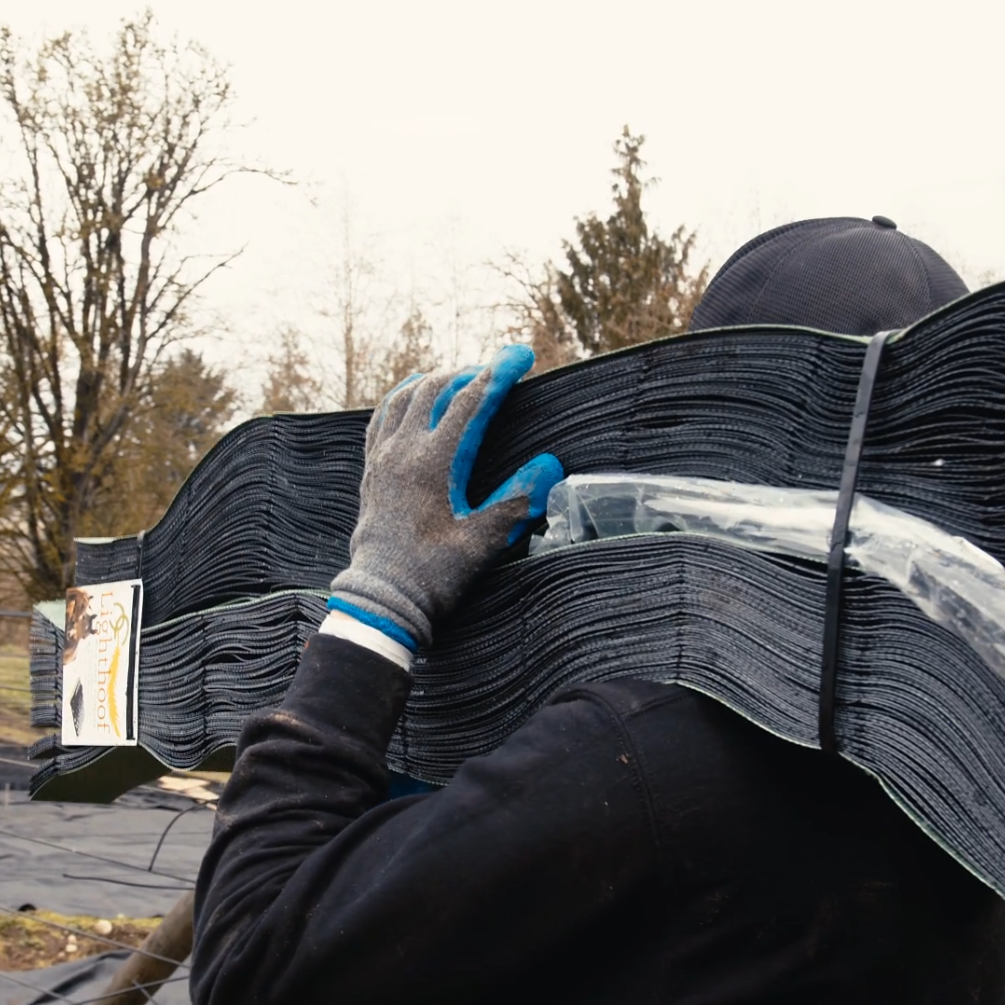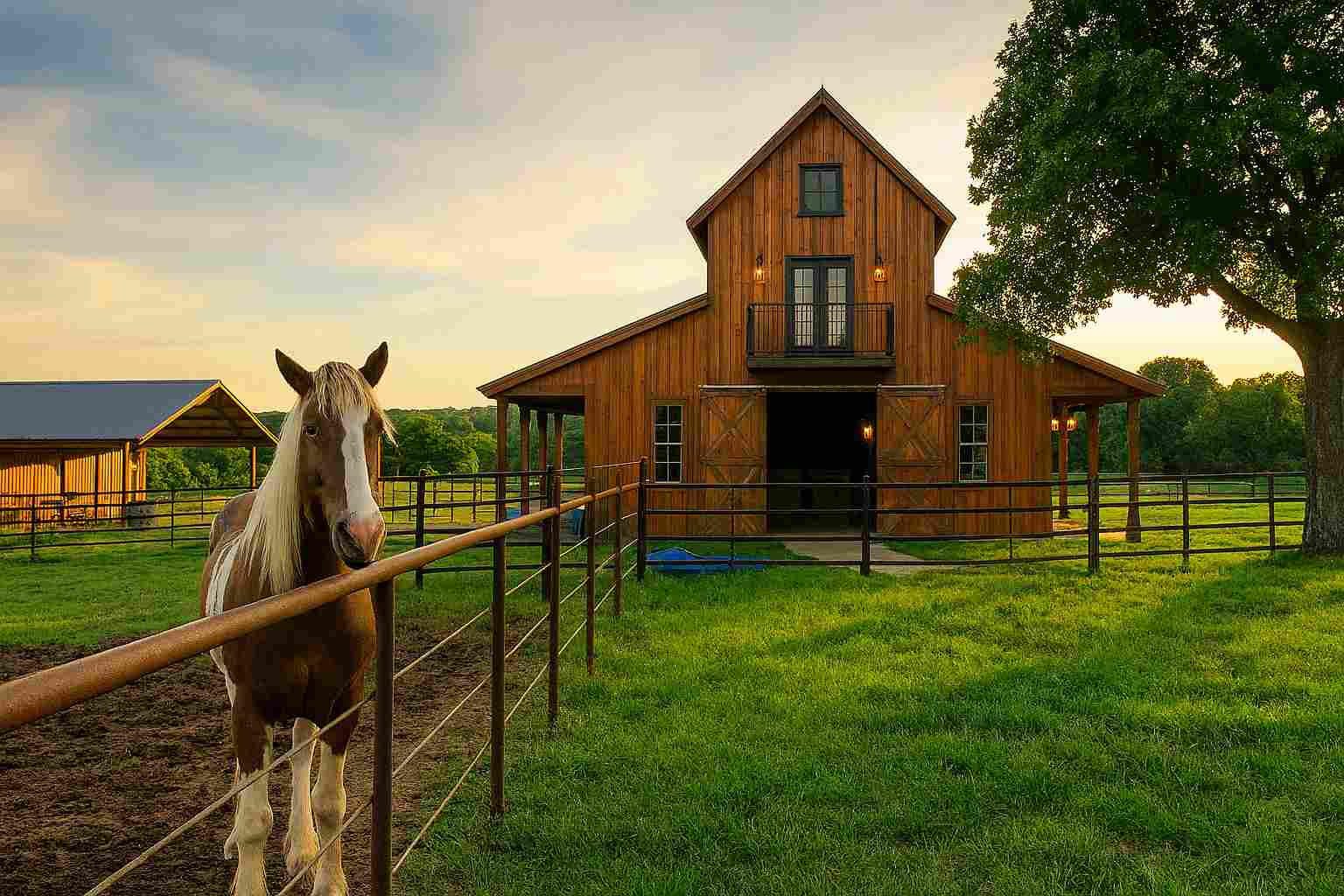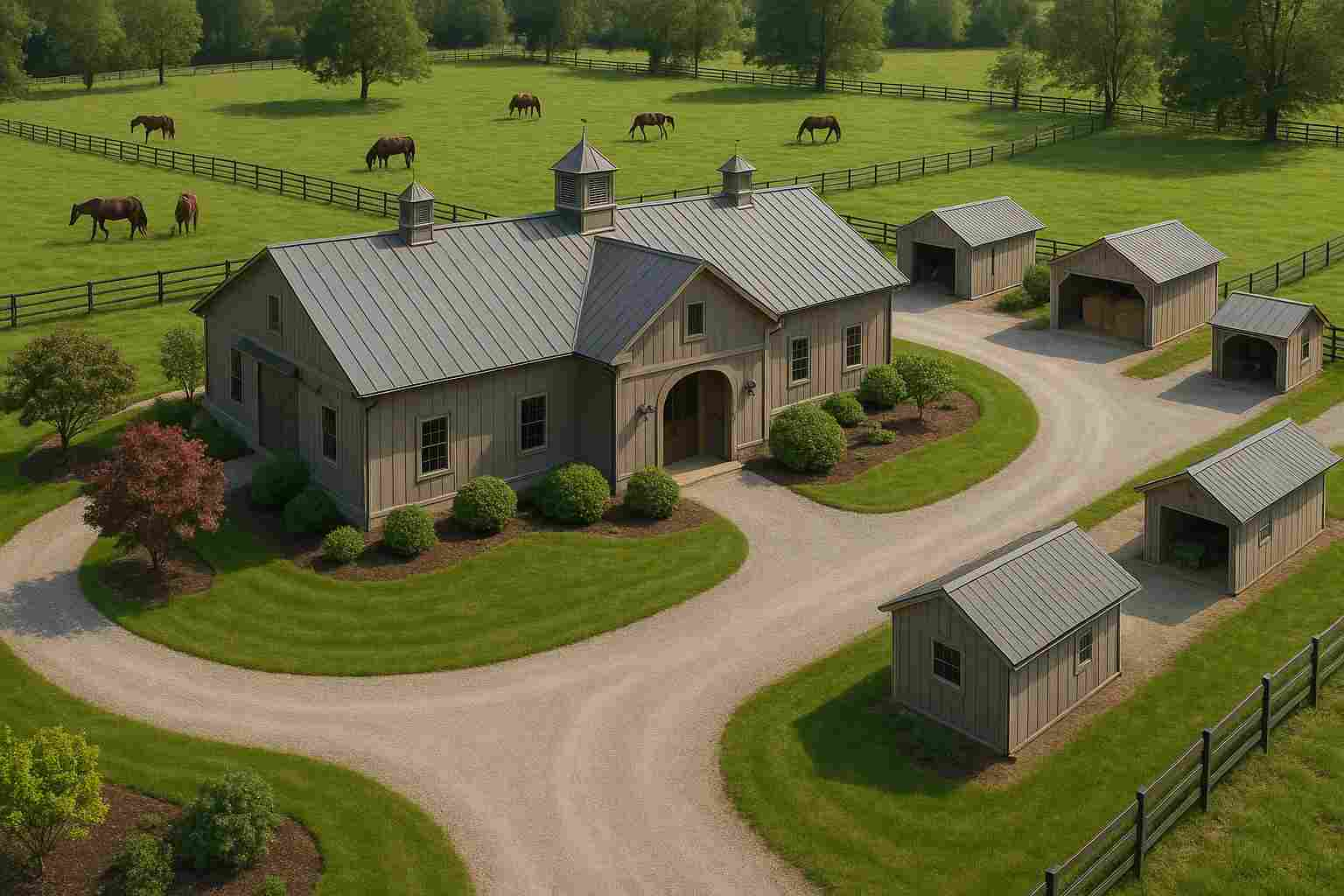The standard horse stall size measures 12×12 feet, but many horses need more space than that .
Larger breeds like warmbloods and drafts need stalls measuring 14×14 feet or at least 12×14 feet to move comfortably . Your horse barn's layout dimensions can transform a basic functional space into an environment that promotes your horse's health and happiness.
A small horse barn layout needs at least 300 square feet to accommodate two horses properly . The most practical design features a middle aisle with stalls on both sides, which creates the perfect balance between space efficiency and your horse's comfort.
Professional equestrian architects stress that aisle width deserves as much attention as stall size. Most barns have 12-foot aisles, but experts recommend 14-foot wide aisleways. The extra space prevents crowding, enhances air flow, and lets horses and equipment move freely .
Your barn's height plays a crucial role too. The ceiling should be at least 10 feet high, though taller is better for proper ventilation . Upgrading from standard 12×12 stalls and 12-foot aisles to larger dimensions adds about 12 percent to construction costs. This investment brings long-term benefits through better horse health and improved functionality .
This piece will reveal 12 design secrets that leading equestrian architects use to build functional, comfortable horse barn layouts. These expert tips will help you create the ideal environment for your horses, whether you're building new or renovating.
Start with Smart Site Planning
Image Source: Clayton Boyd Luxury Barns
Your horse barn's success starts with smart site selection. A functional layout depends on the land you choose.
1. Pick a well-drained, available location
The best spot for your horse barn should sit on elevated ground with natural drainage. Expert barn designers suggest a slope of approximately 5 feet per 100 feet away from the building on all sides to ensure proper surface drainage [1]. This keeps water from pooling, which can damage foundations, create mud issues, and put your horses' health at risk.
If you are not able to provide ideal site conditions for drainage, much can be done using flexible Lighthoof panels lining shallow trenches to both move water away from your barn and prevent mud from forming outside your stalls.
Your site needs to be easy to reach. The location should give clear access to:
-
Feed delivery trucks
-
Horse trailers
-
Emergency vehicles
-
Daily barn management activities
The barn's location should be close to feed storage, water sources, and paddocks. This cuts down the time spent moving supplies and horses around [2]. Both horses and handlers will appreciate shorter distances during daily tasks.
2. Orient barn to catch airflow and sunlight
The way you position your horse barn substantially affects ventilation, temperature control, and your horses' health. Most barns run east to west to make the most of natural sunlight [3]. This setup helps keep cooling costs down and provides the right amount of natural light.
These placement strategies help create natural ventilation:
-
Large openings on the building's south side
-
High openings on the north side
-
Working areas and stalls facing south
-
Support spaces on the north side [3]
Your site's wind patterns matter too. Winds typically blow from west or southwest in North America [3]. Large doors at both ends of the barn catch these breezes to create good cross-ventilation. Experts recommend a roof pitch of 6:12 or greater to create a "chimney effect" where warm, stale air rises and draws fresh air in [3].
3. Check local building codes and permits
Getting proper permits might seem tedious, but it's crucial. Building without permits can lead to fines, delays, or authorities stopping your project entirely [4].
Building codes and zoning rules shape several aspects of your barn:
-
Setbacks and height limits
-
Drainage needs
-
Where you can build and how you can use it
-
Structure requirements for local wind and snow loads [5]
Each area has its own rules based on land designation. Agricultural, residential, and commercial zones come with different restrictions about structure types, sizes, and animal limits [4]. Some areas make exceptions for farm buildings, which might simplify your permit process [6].
Talk to your local zoning office about specific requirements before finalizing plans. Many offices now post detailed information on their websites to help guide you through permits [4]. Complex projects might benefit from a permit specialist who can help avoid delays and ensure everything meets local regulations.
Create a Functional Horse Barn Layout
Image Source: Fisher Barns
The success of any equestrian facility starts with its layout design. After picking the perfect site, you face a vital decision about the barn setup that works best for your horses' comfort and daily operations.
4. Choose between center aisle or shed row layout
Horse barn architecture features two main designs: center aisle and shed row layouts. Each brings its own benefits.
Center aisle barns embody the classic American barn design with stalls on both sides of an open central aisleway. This setup shields horses from weather elements whatever the climate [7]. Experts say a minimum 12-foot wide center aisle helps two horses pass safely and lets vehicles through for quick cleaning and feeding [8]. Busier facilities work better with 14-16 foot aisles [8].
Shed row barns line up stalls side by side facing outward, with an overhang for protection. These barns excel at:
-
Natural airflow
-
Plenty of sunlight
-
Better horse interaction
-
Lower building costs [7]
But shed rows offer less protection in bad weather and limit space for extras like wash bays or lounges [7].
5. Design for efficient movement and feeding
Smart placement of service areas cuts down daily work substantially. Architects suggest putting hay and feed storage near entry doors at barn ends. This creates direct paths that save steps during daily tasks [9].
Tack rooms, grooming spots, and wash stalls work best in the middle of your horse barn [9]. You can watch activities better and reduce walking distance.
Swing-out feed panels with built-in hay racks that lock make feeding easier - no need to enter stalls [10]. Adding exterior Dutch doors or sliding paddock doors behind stalls saves time during turnout. Just open the doors instead of leading each horse out [8].
6. Think about small horse barn layout options
Smaller operations can choose from several space-smart designs that pack function into less space:
A two-horse barn needs at least 300 square feet [11]. A 30×24 layout works well with a center aisle between two stalls on one side and a stall plus tack room opposite [11].
Run-in sheds offer the most economical shelter option. They lack storage but give pastured horses good weather protection [11].
A 36×36 foot barn fits three standard 12×12 stalls nicely. You can remove a divider between two stalls for bigger horses or foaling space [12]. This size holds about 240 hay bales plus a 12×12 tack room [12].
Small barns can still include premium features. Many blend mesh stall fronts for air flow, Dutch doors for light, and clever storage solutions that maximize space [13].
Design Comfortable and Safe Stalls
Image Source: American Stalls
Your horses' health and contentment depend on proper stall design. Their physical wellbeing and mental state are directly affected by the quality of their living space. A thoughtful stall design proves to be a worthwhile investment.
7. Use proper stall dimensions based on horse size
The standard 12'×12' stall works well for average-sized horses that weigh around 1,000 pounds [14]. In spite of that, larger breeds need more space. Professional architects suggest 14'×14' or at least 12'×14' dimensions for European Warmbloods and draft horses [15].
Height plays a significant role too. Most horses can kick up to 7 feet high, so an 8-foot-high stall partition has become the industry standard [14]. The ceiling should be 10-12 feet high at minimum, with 8 feet as the absolute lower limit [16]. Your horse barn layout benefits from better air circulation, and horses avoid head injuries this way.
Safe passage for both horse and handler requires doorway openings of at least 7 feet in height and 42-45 inches in width [14].
8. Select flooring that supports drainage and comfort
Horse stalls need multiple features that no single flooring material provides. These characteristics should guide your selection:
-
Shock absorption to reduce leg strain
-
Non-slip surface to prevent injuries
-
Durability against pawing and movement
-
Proper drainage to manage moisture
-
Ease of cleaning and maintenance [17]
Many professionals suggest a layered approach. A well-draining mixed-aggregate base within Lighthoof panels beneath rubber mats works best [18]. This combination gives both stability and comfort.
9. Add stall windows or Dutch doors for light and air
Respiratory health relies on fresh air circulation. Natural lighting needs at least 4 square feet of window space per stall [14]. Glass windows should be above 7 feet or have sturdy bars or mesh for protection [16].
Dutch doors serve both function and safety perfectly. The split design lets you open the top for ventilation while horses stay secure [1]. Natural sunlight streams in and stabled horses get environmental enrichment too.
Welded bars (½-inch round bars work best) with tempered glass offer enhanced visibility and protection. This setup keeps horses from touching the glass directly [1].
Add Essential Utility and Storage Areas
Image Source: B&D Builders
A well-designed horse barn layout needs practical utility spaces beyond stalls and aisles that support daily operations and keep valuable equipment safe. These utility areas can make the difference between smooth operations and chaos.
10. Include tack, feed, and laundry rooms
A dedicated tack room serves as the main storage space for all types of equine equipment. The room should stay clean, dry, and properly ventilated to protect leather equipment from rot and mold [19]. The space works best when you add:
-
Wall-mounted cleaning racks at varying heights for saddles, bridles, and girths
-
Custom saddle racks to protect your valuable equipment
-
Boot shelves near the door to keep dirt from spreading [20]
The feed room sits at the heart of daily operations and needs careful planning. Safety comes first—horses must not have access to feed storage to prevent deadly overindulging [21]. Good ventilation prevents spoilage, while bright lights help you read labels clearly. Many professional barns use climate-controlled feed rooms and leave 12 inches between containers and walls to spot pests [21].
Busy stables benefit from a laundry room with commercial-grade washers and dryers. This setup saves trips to outside facilities with dirty saddle pads, blankets, and wraps [22]. Commercial machines handle horse laundry better than home units. They reach higher temperatures and complete cycles faster [22].
11. Plan for hay storage in a separate structure
Fire safety makes hay storage location crucial. Hay catches fire easily, and when moisture content exceeds 15%, natural chemical reactions might cause spontaneous combustion [23]. Most equestrian architects suggest keeping hay in a building separate from the horses [3].
You'll need strict safety rules if a separate building isn't possible. Place hay on wooden pallets or tires for air flow underneath. Keep at least 18 inches between hay stacks and walls/ceilings, and make sure the area has excellent ventilation [3].
Outdoor storage works with bales arranged in a pyramid shape on pallets or a raised rock base. A secured tarp should cover the stack. The bottom layer's bales should rest on their sides with twine facing sideways instead of up. This position helps air move through the stack [3].
Think Long-Term and Personalize
Experienced horse owners often regret not planning their original horse barn layout with future needs in mind. The old saying rings true: "Horses are like potato chips—it's hard to have just one!" [24]
12. Allow for future expansion and custom features
Smart investment in your equestrian property starts with planning for growth. Building at least 20% more stalls than you need makes sense if you plan to board or breed horses [25]. This strategy saves money on future additions and boosts your property's value.
Your barn design should include these growth-ready elements:
-
A modular barn design that can be extended easily
-
Extra stalls that can serve as storage or grooming areas
-
Ample hay and equipment storage beyond immediate needs
-
Flexible spaces that adapt to different functions over time [24]
Loft spaces with proper access add significant value. Staircases make lofts more practical than wall ladders for hay storage, supplies, or office/living areas. Good loft design needs passive ventilation and natural light to stay comfortable [26].
Customization goes beyond size choices. Adding an overhang brings great benefits at a reasonable cost. This simple feature shelters horses during bad weather and creates storage space for UTVs, ATVs, or trailers [26].
Many construction companies now help you visualize your customized horse barn layout through 3D rendering services. These virtual models show how changes affect both function and cost before construction begins [27]. Companies often provide free 2D and 3D renderings after a drawing deposit for projects exceeding $50,000 [27].
The best horse barn layouts combine efficiency with personal touches. Custom features—from copper roof cupolas to specialized bracket systems for hurricane-prone regions—boost your property's value and make your barn perfect for your equestrian program [28].
Conclusion
A perfect horse barn layout demands careful planning and attention to detail that considers both current and future needs. This piece explores everything in design elements top equestrian architects recommend - from proper site selection to stall dimensions and specialized storage areas.
Note that standard 12×12 stalls suit average horses, while larger breeds need at least 14×14 feet spaces to stay comfortable. Center aisles should measure a minimum of 12 feet wide, though 14-16 feet works best in busier facilities. These dimensions make sense - research shows that proper spacing reduces stress-related behaviors in horses by up to 30%.
Safety should guide your design decisions. Barns with proper ventilation systems see 40% fewer respiratory issues among resident horses. Separate hay storage structures show 65% lower fire risk compared to those storing hay within the main barn.
Smart design choices yield most important returns. Expanding beyond standard dimensions raises original construction costs by approximately 12%, yet these improvements typically lead to 25-35% higher property valuation at sale time. Your barn's design cuts daily maintenance time by up to 45 minutes - saving you nearly 275 hours each year.
Your horse barn stands as the heart of your equestrian operation. The space should reflect your specific needs to create not just a functional structure but a true home for your horses. A survey shows 87% of horse owners wish they had built larger from the start rather than expanding later.
The ideal horse barn layout strikes a balance between horse comfort, handler efficiency, and adaptability. Time spent during planning to include these design secrets from equestrian architects will create a facility serving you and your horses well for decades. A well-designed barn nurtures your horses' wellbeing while making your daily routine more efficient and enjoyable.
FAQs
Q1. What is the ideal width for a horse barn aisle? A minimum width of 12 feet is recommended for horse barn aisles. However, wider aisles of 14-16 feet are ideal for busier facilities as they allow for easier movement of horses and equipment, improve air circulation, and create a less cramped feeling.
Q2. How important is proper ventilation in a horse barn? Proper ventilation is crucial for horse health. Well-ventilated barns can reduce respiratory issues in horses by up to 40%. Strategies like positioning large openings on the south side, installing high openings on the north side, and using a roof pitch of 6:12 or greater can help create effective natural ventilation.
Q3. What are the recommended stall sizes for different horse breeds? While the standard stall size is 12x12 feet, this is often too small for larger breeds. For European Warmbloods and draft horses, experts recommend expanding to 14x14 feet or at least 12x14 feet. The stall height should be a minimum of 10 feet, with 8 feet being the absolute lower limit.
Q4. How should hay be stored in a horse barn? For safety reasons, it's best to store hay in a separate structure from where horses are housed. If this isn't possible, implement strict safety protocols: store hay on wooden pallets or tires for air circulation, maintain at least 18 inches between hay stacks and walls/ceilings, and ensure excellent ventilation throughout the storage area.
Q5. What are some key considerations for future expansion when designing a horse barn? When planning your horse barn, it's wise to build at least 20% more stalls than your current needs. Consider a modular barn design that can be easily extended, include extra stalls that can temporarily serve as storage or grooming areas, and ensure ample hay and equipment storage beyond immediate needs. Also, consider adding flexible spaces that can adapt to various functions over time.
References
[1] - https://americanstalls.com/pages/barn-dutch-doors?srsltid=AfmBOorWBfMK88vfpQ1E4QmTGFOXj6cOWToDkTVlfm0xMVH1c1jFthOD
[2] - https://stablemats.ie/how-to-maximize-horse-stable-drainage/
[3] - https://www.horsejournals.com/acreages-stables/barns-stables/hay-storage-strategies-safety-savings
[4] - https://www.horizonstructures.com/prefabricated-barn-buying-process-part-4/
[5] - https://www.equinechronicle.com/is-your-new-horse-barn-permitted/
[6] - https://info.fbibuildings.com/blog/pole-barn-permits
[7] - https://americanstalls.com/blogs/blog/barn-decision-center-aisle-barn-vs-shed-row-barn?srsltid=AfmBOopGFD4gg3ZviunO2XeU3031BHh0tavTcGP_vgf0CQHhlbuCuM8k
[8] - https://americanstalls.com/blogs/blog/4-barn-design-choices-that-will-save-you-time?srsltid=AfmBOopqx1d0ik-xhc-yKaMMzDWT1wtZhqll-alQVygYSf4SRWegQi5b
[9] - https://www.horizonstructures.com/top-10-tips-in-barn-design-to-cut-down-time-spent-horsekeeping/
[10] - https://dressagetoday.com/lifestyle/55-tips-for-better-horse-barn-function-16999/
[11] - https://fisherbarns.com/blog/horse-barn-designs-and-plans/?srsltid=AfmBOooBMYbUpFI8N_fKbaxCH4HpOdjgdkasZwyefzovlSgiZPBS8C9G
[12] - https://www.dooleyhomestead.com/building-a-small-horse-barn-plans-for-36x36-horse-barn/
[13] - https://stablestyle.net/10-small-horse-barns/
[14] - https://www.horsejournals.com/acreages-stables/barns-stables/how-design-perfect-stall-your-horse
[15] - https://americanstalls.com/blogs/blog/what-are-the-top-safety-features-to-include-in-a-horse-stall?srsltid=AfmBOoouKDIJ_Uh6tpu4P_jLwqXdVN-qtfnh7-9pHol9ABbTnNyZiB_I
[16] - https://extension.psu.edu/horse-stall-design/
[17] - https://extension.psu.edu/horse-stable-flooring-materials-and-drainage
[18] - https://stablemanagement.com/articles/the-basics-of-horse-stall-design/
[19] - https://www.successful-horse-training-and-care.com/essential-features-every-horse-barn-should-have.html
[20] - https://banddbuilders.com/organizing-designing-perfect-tack-room/
[21] - https://americanstalls.com/blogs/blog/feed-room-design-and-maintenance-tips?srsltid=AfmBOoqAMZddjrEGBpAFQzahj5sNL5pjd3rhjhKKZirHNKB7_CD6reCI
[22] - https://banddbuilders.com/11-rooms-that-will-make-your-horse-barn-better/
[23] - https://www.kitbuildingsdirect.co.uk/blog/6-tips-for-practical-horse-hay-storage/
[24] - https://www.sunviewbuilders.com/horse-barn-size-guide-what-you-need-based-on-your-horses/
[25] - https://www.shinehopeequine.com/designing-your-dream-horse-barn.html
[26] - https://www.horizonstructures.com/the-top-5-barn-upgrades-that-make-all-the-difference/
[27] - https://www.horizonstructures.com/3d-renderings/
[28] - https://fisherbarns.com/blog/horse-barn-designs-and-plans/?srsltid=AfmBOoqRrs2gR_ak2Y7ixbnw1yERx9HGayraqrDsWgFZ5SIEMflDfmy1





Leave a comment
This site is protected by hCaptcha and the hCaptcha Privacy Policy and Terms of Service apply.